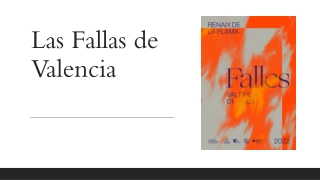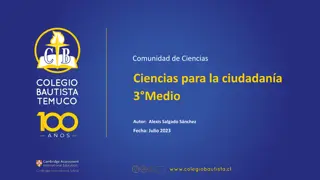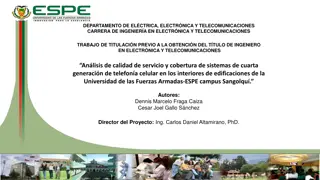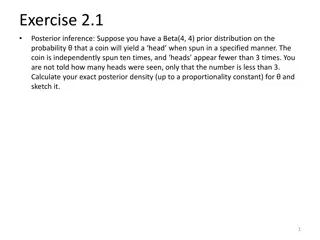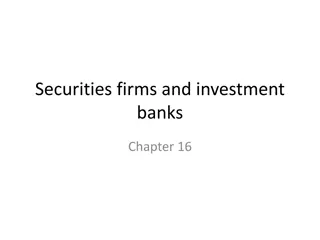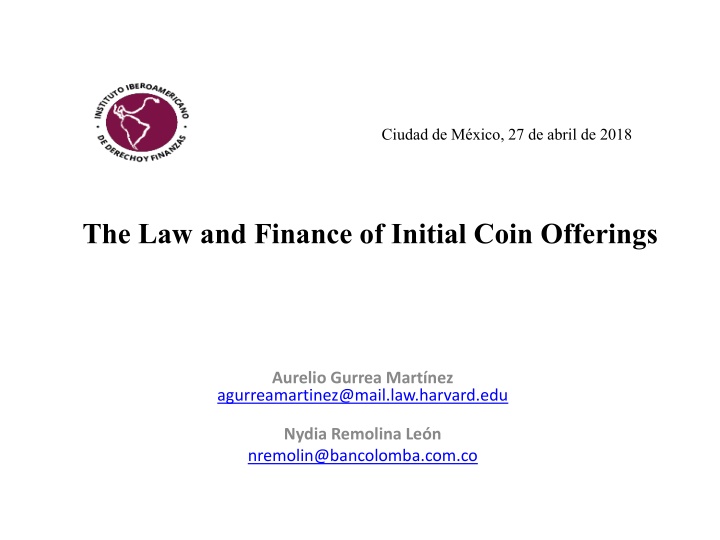
Law and Finance of Initial Coin Offerings in 2018
Explore the concept, importance, regulation, and associated risks of Initial Coin Offerings (ICOs) in the evolving landscape of blockchain technology. Discover how ICOs are changing the way companies raise capital, the different types of tokens, and the legal implications surrounding ICOs in various jurisdictions. Understand the risks of fraud and money laundering associated with ICOs and the compliance measures needed for a successful ICO.
Download Presentation

Please find below an Image/Link to download the presentation.
The content on the website is provided AS IS for your information and personal use only. It may not be sold, licensed, or shared on other websites without obtaining consent from the author. If you encounter any issues during the download, it is possible that the publisher has removed the file from their server.
You are allowed to download the files provided on this website for personal or commercial use, subject to the condition that they are used lawfully. All files are the property of their respective owners.
The content on the website is provided AS IS for your information and personal use only. It may not be sold, licensed, or shared on other websites without obtaining consent from the author.
E N D
Presentation Transcript
Ciudad de Mxico, 27 de abril de 2018 The Law and Finance of Initial Coin Offerings Aurelio Gurrea Mart nez agurreamartinez@mail.law.harvard.edu Nydia Remolina Le n nremolin@bancolomba.com.co
1. Concept and importance (1/2) Initial Coin Offerings as a new way to raise capital . In 2017, companies have raised $4 billion in the United States In the first three months of 2018, ICOs raised more than the whole of 2017: $6.3 billion ICO market was 40% of the size of the IPO market and 30% of the size of the venture capital VC market in Q1 2018. $1.7 billion was raised by Telegram in only two company s pre- ICO sales in March.
1. Concept and importance (2/2) There are many ways to raise capital: Families Business angels Venture capitalists Crowdfunding IPOs What is different from other ways to raise capital? Use of blockchain technology What is blockchain? How does it work? Issuer receives cryptocurrencies What is a cryptocurrency? Companies do not issue shares or bonds but something called tokens What is a token?
2. Concept and regulation of tokens What is a token ? Tokens are digital assets used in connection with decentralized services, applications, and communities ( token networks ). It is something that give certain rights in the company. These rights are defined in something called the whitepaper . Some token sales take place when or after the token network is launched. Other token sales happen long before the token network has genuine functionality ( direct token pre-sales ) Type of tokens: It differs across jurisdictions Our paper: Security (or asset) tokens: it depends on how a particular jurisdiction defines a token. In the US, for example, securities are defined according to the Howey test. Utility tokens: everything else. According to FINMA, non-security tokens can be divided into: Payment tokens: cryptocurrencies Utility tokens: rights to future services
3. AML and associated risks ICOs are also vulnerable to the risk of fraud or money laundering. Both developers and exchanges involved in the sale of an ICO token would be liable to comply with the relevant statutes around anti-money laundering and know-your-customer (KYC) Where ICOs qualify as financial instruments, it is likely that firms involved in ICOs conduct regulated investment activities, in which case they need to comply with the relevant legislation, including for example: the Prospectus Directive The Markets in Financial Instruments Directive (MiFID), The Alternative Investment Fund Managers Directive (AIFMD); and The Fourth Anti-Money Laundering Directive.
4. What is a token from an accounting and finance perspective? Why does it matter? (1/2) The registration of tokens in the issuer s and token-holder s balance-sheet Issuer Digital ASSET DEBT/ EQUITY Investor ASSETS (rights) Digital ASSET
4. What is a token from an accounting and finance perspective? Why does it matter? (2/2) Why does it matter? Priority in case of insolvency? Risk of insolvency? Financial ratios? Covenants? Corporate governance? Cost of capital? Accounting issues: Token given access to future services future expenses? Future sales? Valuation of digital assets Impairment of the digital assets received by an issuance of tokens what happens if there is a decline in the value of cryptocurrencies?
5. How should securities regulators deal with ICOs? How should securities regulators deal with tokens? Prohibition: Chinese approach Full control ex ante: Mexican approach Pros: the regulator makes sure that all security tokens comply with securities law; the supervisor has the ability to know how much many is raised through ICOs. Cons: More costly (employees, qualification, delay, etc.) Selective control ex ante: US approach This system can be enhanced by adding control ex post how?
6. Corporate Governance Issues Agency problems and shareholders rights What is a shareholder entitled to? (Common stock, dual-class shares, preferred shares, etc.) Nature and feature of token-holders from a CG perspective What is a tokenholder entitled to? The importanceof the whitepaper Governancerisks of becoming a tokenholder No clear legal status could a tokenholder be considered a shareholder? If so, relationship with existing shareholders? Weighted agency problems Risk of being considereda de facto director How should we protect token-holders? If the token-holderis a security-tokenholder White paper Securities regulation Corporatelaw? If the token-holderis an utility tokenholder Just white paper?
7. Conclusion ICOs are becoming a very important tool to raise funds. Many legal, accounting and finance issues arise in ICOs Unlike what happens in other aspects of finance and securities regulation, there is no a clear position about the best way to approach ICOs it differs across jurisdictions. When dealing with ICOs, regulators should promote three (sometimes competing) goals: Innovation and development Investor protection Financial stability Best way to do so?

![[PDF READ ONLINE] LAS VEGAS TRAVEL GUIDE 2023: DISCOVERING THE EXCITEMENT AND BE](/thumb/2060/pdf-read-online-las-vegas-travel-guide-2023-discovering-the-excitement-and-be.jpg)

